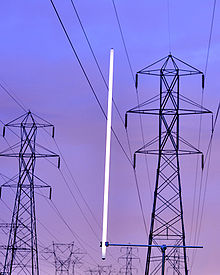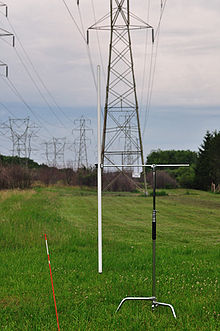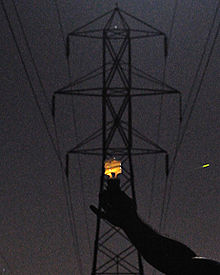| Revision as of 16:27, 2 July 2010 editWtshymanski (talk | contribs)Extended confirmed users76,122 edits Wiki editors rush in where angels fear to tread← Previous edit | Revision as of 16:44, 2 July 2010 edit undoJc3s5h (talk | contribs)Extended confirmed users, Pending changes reviewers, Rollbackers32,887 edits →Volt-ampere: replyNext edit → | ||
| Line 20: | Line 20: | ||
| I am not happy with your edit summary in your recent edit to ] "Water is wet, sky is blue, and see your local dictionary for the definition of "is" and "the".. foolish requested reference)". Considering that Ciletti et al. list three different kinds of power and that's just on page 87, it is reasonable for the reader to suppose that all phrases which include "power" might have separate and distinct meanings. Phrases which are invented by a Misplaced Pages editor based on meanings in general-interest dictionaries have no place in an article like this, and every such phrase should have a citation. | I am not happy with your edit summary in your recent edit to ] "Water is wet, sky is blue, and see your local dictionary for the definition of "is" and "the".. foolish requested reference)". Considering that Ciletti et al. list three different kinds of power and that's just on page 87, it is reasonable for the reader to suppose that all phrases which include "power" might have separate and distinct meanings. Phrases which are invented by a Misplaced Pages editor based on meanings in general-interest dictionaries have no place in an article like this, and every such phrase should have a citation. | ||
| Also, I used to own a copy of ISO 100, but I became so disgusted with it I threw it away. My issue with it was that it was just a hodgepodge of definitions copied from various IEEE standards, and many of these standards adopted specialized definitions of terms; the specialized definitions often departed from the definitions in the general electrical and electronic literature. Indeed, since standards often don't bother to define a term unless it was being used in a non-standard way, ISO 100 gave me the impression of containing mostly weird definitions and few useful, general-interest definitions. | Also, I used to own a copy of <s>ISO</s> IEEE 100, but I became so disgusted with it I threw it away. My issue with it was that it was just a hodgepodge of definitions copied from various IEEE standards, and many of these standards adopted specialized definitions of terms; the specialized definitions often departed from the definitions in the general electrical and electronic literature. Indeed, since standards often don't bother to define a term unless it was being used in a non-standard way, <s>ISO</s> IEEE 100 gave me the impression of containing mostly weird definitions and few useful, general-interest definitions. | ||
| I will have to check to see if their definition of "active power" is accurate; I have not heard the term before. (I must admit, however, that my experience with 50 or 60 Hz AC power is limited.) ] (]) 15:00, 2 July 2010 (UTC) | I will have to check to see if their definition of "active power" is accurate; I have not heard the term before. (I must admit, however, that my experience with 50 or 60 Hz AC power is limited.) ] (]) 15:00, 2 July 2010 (UTC) | ||
| : I admire your courage...I'm scared to edit articles for areas in which I have no experience, since then I'm liable to have more knowledgeable editors correct me on elementary matters of vocabulary. I don't know which of the ISO 100 standards you refer to, my reference was to an IEEE standard which seems to think "active power" is a standard description. Who is "Ciletti" when he's up and dressed? --] (]) 16:27, 2 July 2010 (UTC) | : I admire your courage...I'm scared to edit articles for areas in which I have no experience, since then I'm liable to have more knowledgeable editors correct me on elementary matters of vocabulary. I don't know which of the ISO 100 standards you refer to, my reference was to an IEEE standard which seems to think "active power" is a standard description. Who is "Ciletti" when he's up and dressed? --] (]) 16:27, 2 July 2010 (UTC) | ||
| ::Michael D. Ciletti was one of the authors of chapter 3, "Linear Circuit Analysis", of ]'s Electrical Engineering Handbook, which is cited in the article. Upon closer examination, I see that the "Power and Energy" section (which contains the material cited in the article) within that chapter was written by Norman Balabanian (affiliated with Syracuse U. as of 1993) and Theodore A. Bickart (who I took a class from at Syracuse U. in the early eighties; it might have been my linear circuits class, I'm not sure.) ] (]) 16:44, 2 July 2010 (UTC) | |||
Revision as of 16:44, 2 July 2010
blanked the page.
Fluorescent lamp photo
I am the photographer of the fluorescent lamp glowing under the power lines. I did use Photoshop to crop and sharpen the picture but it is entirely accurate. I shoot in Nikon RAW so I do not use any in camera color correction or sharpening.

I set the equipment up before dusk so I had enough light to focus properly. I originally had the tube (an 8 footer) clamped in the middle but the glow below the clamp was distinctly dimmer so I moved the lamp up for the real shot.

And just for fun, here's a shot of a compact fluorescent glowing. I took this the night before, along with some of the 8' tube hand held. The short exposure required to defeat my inevitable shaking of the lamps required a high ISO that made the photos too grainy for my taste. That's what led to the clamped shots the next night. BTW, the green streak is a lightning bug flying through the scene.

- (Wtshymanski Comments about the first picture, added here by Selladour)Interesting picture, but is it a composite? Something about this doesn't quite look right, and I was a little alarmed to see that Photoshop was involved in making this image. Could you explain it a little? Thanks, --Wtshymanski (talk) 13:58, 23 June 2010 (UTC)
- Wtshymanski, I'm new at this, so please forgive and instruct on any breaches of etiquette. The photographer (my brother) has put the originals above, so I hope you'll agree there were no shenanigans and that it is worth putting the picture back on the fluorescent tube page. The next time you drag your (no doubt) lovely and long suffering bride to the left edge of the middle of nowhere North Dakota to photograph power lines, you gotta bring a fluorescent tube. You can pick it up at the ND Walmart and return it when you are done (you don’t even have to open the package). If you point the tube at the power line like a light saber, it will glow (dimly), if you hold it towards the middle with two hands, it will be dark between your hands but lit beyond them(you are a conductor, so your hands will be at the same potential). The Electric field drops off by 1/(r squared), so if you hold the tube parallel to the wires, it will go out. If you hold the tube tangent to the circumference of a circle centered on the wire, it should also go out. I’m not sure why you’re still sitting here; go get a fluorescent tube and visit your local power lines. You just gotta. Thanks Selladour (talk) 01:53, 24 June 2010 (UTC)
- PS, the CFL only glows visibly when we hold(and ground out) the bottom. I guess it is too small to have a significant change in the electric field unless we put the electrode at zero.
- The stand is metal with rubber clamps and feet. The bulb was dimmer below the clamp. The next time I visit my brother, I'll have to try it with a short horizontal arm; being close to the vertical metal tube should reduce the electric field. (The power line are next to my brother's house)Selladour (talk) 02:20, 24 June 2010 (UTC)
Hydroelectricity
Hello Wtshymanski. Being the two latest editors (along with NortyNort) who edited the article, I would like to hear on what you think about the new merged version. I intend to change the article to that version soon as discussed on the article talkpage. Please share your views here. Thanks. Kind regards. Rehman 13:36, 26 June 2010 (UTC)
Volt-ampere
I am not happy with your edit summary in your recent edit to Volt-ampere "Water is wet, sky is blue, and see your local dictionary for the definition of "is" and "the".. foolish requested reference)". Considering that Ciletti et al. list three different kinds of power and that's just on page 87, it is reasonable for the reader to suppose that all phrases which include "power" might have separate and distinct meanings. Phrases which are invented by a Misplaced Pages editor based on meanings in general-interest dictionaries have no place in an article like this, and every such phrase should have a citation.
Also, I used to own a copy of ISO IEEE 100, but I became so disgusted with it I threw it away. My issue with it was that it was just a hodgepodge of definitions copied from various IEEE standards, and many of these standards adopted specialized definitions of terms; the specialized definitions often departed from the definitions in the general electrical and electronic literature. Indeed, since standards often don't bother to define a term unless it was being used in a non-standard way, ISO IEEE 100 gave me the impression of containing mostly weird definitions and few useful, general-interest definitions.
I will have to check to see if their definition of "active power" is accurate; I have not heard the term before. (I must admit, however, that my experience with 50 or 60 Hz AC power is limited.) Jc3s5h (talk) 15:00, 2 July 2010 (UTC)
- I admire your courage...I'm scared to edit articles for areas in which I have no experience, since then I'm liable to have more knowledgeable editors correct me on elementary matters of vocabulary. I don't know which of the ISO 100 standards you refer to, my reference was to an IEEE standard which seems to think "active power" is a standard description. Who is "Ciletti" when he's up and dressed? --Wtshymanski (talk) 16:27, 2 July 2010 (UTC)
- Michael D. Ciletti was one of the authors of chapter 3, "Linear Circuit Analysis", of Richard C. Dorf's Electrical Engineering Handbook, which is cited in the article. Upon closer examination, I see that the "Power and Energy" section (which contains the material cited in the article) within that chapter was written by Norman Balabanian (affiliated with Syracuse U. as of 1993) and Theodore A. Bickart (who I took a class from at Syracuse U. in the early eighties; it might have been my linear circuits class, I'm not sure.) Jc3s5h (talk) 16:44, 2 July 2010 (UTC)